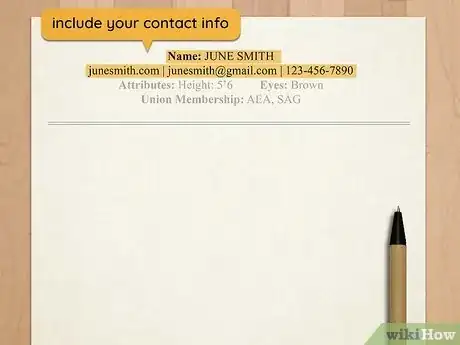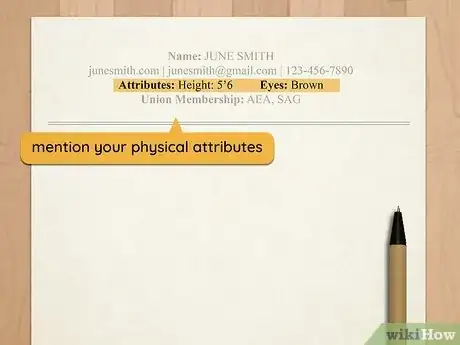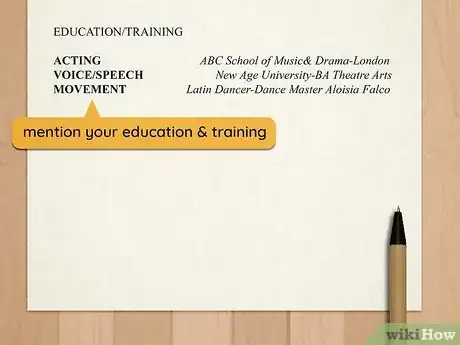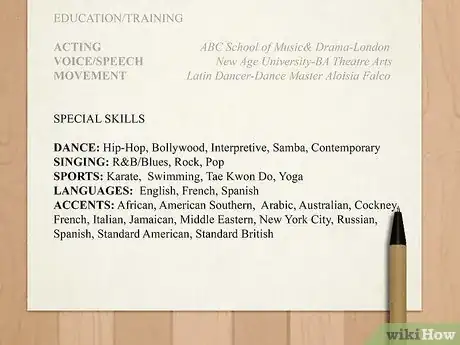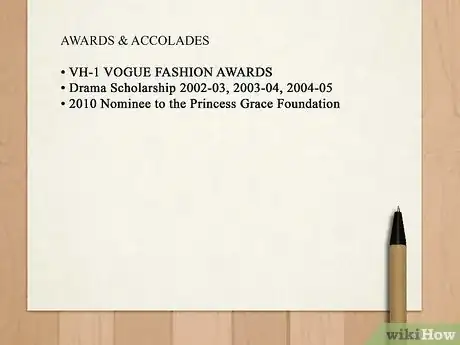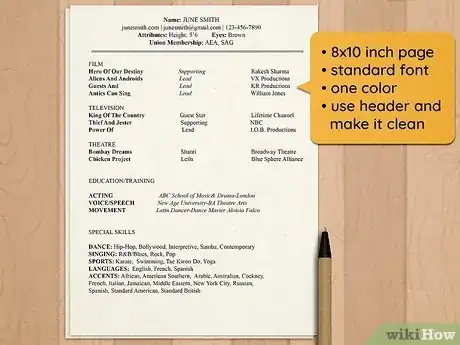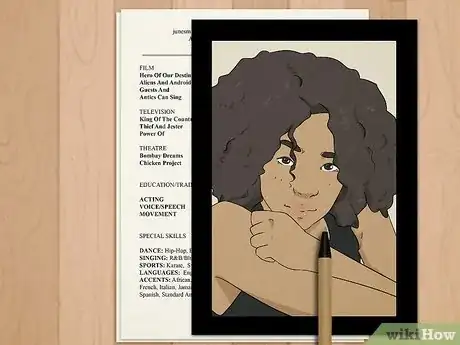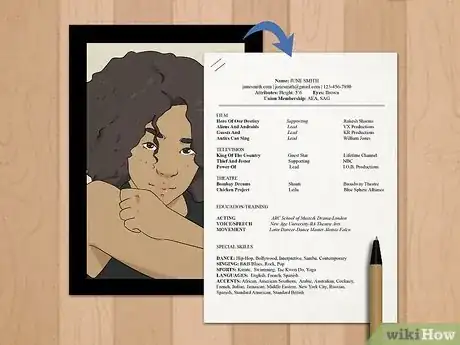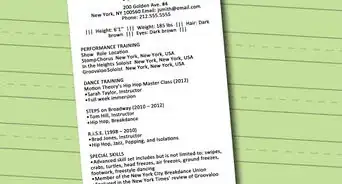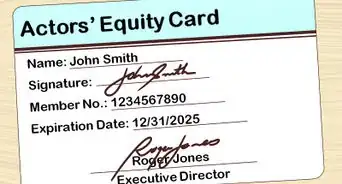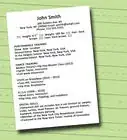This article was co-authored by Patricia Chukerman and by wikiHow staff writer, Dan Hickey. Patricia Chukerman is an Image Consultant & Marketing Specialist and the Owner of Paperworks Image Consulting and Stoned on Rocks. With more than 36 years of experience, she specializes in helping companies decide how to market themselves. In addition to her work with businesses, she also has more than four years of acting experience and more than five years of crafting experience. Patricia earned her BA from The University of Illinois Chicago. Patricia is also the President of the Dania Beach Chamber of Commerce and the President of the Hollywood Florida Scholarship Foundation.
wikiHow marks an article as reader-approved once it receives enough positive feedback. This article received 16 testimonials and 100% of readers who voted found it helpful, earning it our reader-approved status.
This article has been viewed 421,889 times.
An acting resume is a snapshot of who you are and the experience you have—but what should you include, especially if you’re just starting out? Whether you’re a beginner actor with no experience or a seasoned thespian, a professional-looking resume that showcases what you can do can help you land your dream role. We’ve put together a guide with all the information you need to include and how to format it for success. If you’re ready to go out there and break a leg, read on!
Steps
What to Include on Your Acting Resume
-
1Include your name and contact information at the top of your resume. Use your stage name if it’s different from your real name since that’s how you will be known. Center and bold your name on its own line at the top of the page, then add your contact information in 1 line beneath it. Include a phone number and email address that you check regularly so casting agents can contact you with questions (or offer you a role!).[1]
- If you have an agent, include their name (or the agency name) along with a phone number and email address where they can be reached on a new line beneath your contact information.[2]
- If you are working through an agent, remember that legitimate agencies and agents do not charge you. They take a percentage of whatever they book you for.[3]
- Include the URL to your professional acting website if you have one.[4]
-
2List your professional or union affiliations. If you’re a union actor, indicate this near the top of your resume beneath your contact information. This is important because union or equity actors are not allowed to audition for non-union or non-equity roles. If you don’t have an affiliation like this, you don’t have to list anything.[5]
- Unions you might list include SAG-AFTRA or Equity/AEA.
- List your union after your name (John Smith, SAG-AFTRA) or on a separate line (Union: SAG-AFTRA).
Advertisement -
3Describe your basic physical attributes. Even though you’ll include a headshot with your resume, include your height (to help the casting team envision a stage picture) and your hair and eye color. Weight is rarely important and should only be included if the casting call specifies a weight range or you’re asked to fill out a size card for a role.[6]
- If you’re auditioning for a singing role, include your voice type (soprano, alto, tenor, baritone, or bass) and your vocal range if you know your lowest and highest notes (for example, C3–A4).
- Do not list your age or date of birth unless you’re under 18 years old. Keeping your age vague increases the number of roles you could be a good fit for.
- List your traits with the attribute bolded (Height: 5’11” Voice Type: Tenor) in one line beneath your contact information.
-
4Include the most notable roles you’ve played. Divide your experience by type—stage, television, and film—and list your roles in either reverse-chronological order or in order of most to least impressive. If you have an established acting career, include only your most prominent roles from the last 10 years. If you’re just getting started, list anything you’ve got (community theater and college productions count!).[7]
- Leave out the dates of your roles to avoid exposing your age.
- Don’t include modeling or extra work—stick with relevant acting experience.
-
5List your role experience in a 3-column layout. For stage, television, and film roles, the first column will always be the name of the production, show, or movie. The second column will be the character’s name or type of role. The third column will list the production company or network, location, and director.[8] Here are some examples:
-
Stage: Hello, Dolly! — Dolly — Lyceum Theatre, Manhattan, NY
- Only list the director if they’re very well-known (you can put their name alongside the company’s name or in place of the location if you’re short on space).
-
TV: 8 Simple Rules — Recurring — ABC/James Widdoes
- Types of roles in TV credits are series regular, recurring, guest star, or co-star.
-
Film: The Mummy — Lead — Universal Studios/Stephen Sommers
- Types of roles in film credits are lead, supporting, principal, or featured.
-
Stage: Hello, Dolly! — Dolly — Lyceum Theatre, Manhattan, NY
-
6Mention your acting education and training. If you have a degree in acting, list the title of your degree and your major, the school’s name, and the school’s location (city and state) in a 3-column layout. Also include any workshops, masterclasses, seminars, or training you’ve had outside of a school setting (a list or 3-column layout will both work). [9]
- For example: “BFA, Acting — New York University — New York City, NY”
- Mention any specialized training or certifications related to acting, like stunt coordination or choreography, and any well-known teachers or coaches you’ve studied with.
- Your graduation dates are optional. To keep your age vague, leave them out.
- List any training in acting-related fields like music (especially singing), dance, improv, or stunts.
-
7Highlight special skills that make you stand out from other applicants. After your education, make a simple list of anything you can do that would catch a casting agent’s attention. These might be things like juggling, acrobatics, dancing, foreign languages and accents, musical instruments, or stunts. Only list things you can do well and at a moment’s notice.[10]
- For example: “Special Skills: aerial acrobatics, singing (classical and pop), dance (tap and contemporary), guitar, piano, French accent, German accent, juggling.”
- Some more special skills casting agents might look for are crying on cue, voiceover acting, improvisation, stage combat or weapons handling experience, clowning, or miming.
- The more unique or specialized your skill sets are, the more you’ll stand out. For example, instead of “dance,” you could put “ballet and samba.”
-
8Add any awards or accolades you’ve received for your acting. Show casting or hiring agents you’ve been recognized for your talent, work ethic, and dedication to make them want to work with you. List awards, scholarships, nominations, and honorary mentions you’ve received in acting or a related field. If you haven’t received a notable award yet, leave this section out.[11]
-
9Customize your resume for specific roles or auditions. Decide which roles, experiences, and special skills are the most relevant to the role you’re auditioning for. For example, if you’re trying out for a stage role, list your live theater experience first instead of TV or film roles (and vice versa). If you have enough experience, consider separate resumes for stage auditions and on-camera auditions.[12]
- Save your resume in an easy-to-access location on your computer for fast editing and updating. If you’re submitting electronically, save it as a PDF file so it’s readable on any device.
Acting Resume Format and Presentation
-
1Arrange your resume so it fits on one 8x10 inch (20x25 cm) page. If you’re struggling to make everything fit, edit down your information so you’re only including the most relevant and impressive roles and awards. A smaller font can help fit everything—just make sure it’s no smaller than size 10 for easy readability.[13]
- Stick with a clean, professional font like Times New Roman or Arial.
- Stick with one font color (black).
- Make your resume stand out by keeping it super clean and readable. Bold your headers and leave plenty of white space on the page so it’s easy to skim quickly.
-
2Include a good headshot with your resume. A headshot is an 8x10 inch (20x25 cm) color photo of you from the shoulders up. It shows what you currently look like and helps casting agents remember you and your audition. A professional photo shoot looks the best, but you can take your own headshot if you have the right equipment and want to save some money.[14] Here are some tips for a fantastic headshot:
- Wear a simple, solid-colored shirt. Dark colors photograph better than light colors, and white should be avoided.
- Wear your hair in a simple, everyday style and keep your makeup to a minimum (the photographer can make touch ups during editing if necessary).
- Pose in a natural position. Your shot shouldn’t include your hands or any props.
- Remember, casting agents want to see the natural you. Wild clothing, makeup, hair, or poses will distract them (and hurt your chances of getting the role).
-
3Staple your resume to the back of your headshot. If your printed resume is larger than 8x10 inches (20x25 cm), trim the excess paper away so it fits—just make sure you’re not cutting off any text. Staple the top 2 corners to securely attach the resume to the headshot.[15]
- Stapling ensures your resume and headshot don’t get separated. Avoid using paper clips or tape.
- Don’t print your resume on the back of your headshot. It’s costly and inconvenient to print large photos every time you update your resume.
Expert Q&A
-
QuestionHow do you succeed in acting auditions?
 Patricia ChukermanPatricia Chukerman is an Image Consultant & Marketing Specialist and the Owner of Paperworks Image Consulting and Stoned on Rocks. With more than 36 years of experience, she specializes in helping companies decide how to market themselves. In addition to her work with businesses, she also has more than four years of acting experience and more than five years of crafting experience. Patricia earned her BA from The University of Illinois Chicago. Patricia is also the President of the Dania Beach Chamber of Commerce and the President of the Hollywood Florida Scholarship Foundation.
Patricia ChukermanPatricia Chukerman is an Image Consultant & Marketing Specialist and the Owner of Paperworks Image Consulting and Stoned on Rocks. With more than 36 years of experience, she specializes in helping companies decide how to market themselves. In addition to her work with businesses, she also has more than four years of acting experience and more than five years of crafting experience. Patricia earned her BA from The University of Illinois Chicago. Patricia is also the President of the Dania Beach Chamber of Commerce and the President of the Hollywood Florida Scholarship Foundation.
Image Consultant & Marketing Specialist Have the confidence to know that if your agent didn't think you could handle the audition, they would not have proposed you for the part! Do your best!
Have the confidence to know that if your agent didn't think you could handle the audition, they would not have proposed you for the part! Do your best! -
QuestionHow can I become an actor?
 wikiHow Staff EditorThis answer was written by one of our trained team of researchers who validated it for accuracy and comprehensiveness.
wikiHow Staff EditorThis answer was written by one of our trained team of researchers who validated it for accuracy and comprehensiveness.
Staff Answer wikiHow Staff EditorStaff AnswerThere are lots of different ways people become actors. Most people go through some kind of training (college or other acting programs), put together a resume and a headshot, and take auditions until they land a role. Getting an agent can help you find more acting experience to fill out your resume and get you noticed.
wikiHow Staff EditorStaff AnswerThere are lots of different ways people become actors. Most people go through some kind of training (college or other acting programs), put together a resume and a headshot, and take auditions until they land a role. Getting an agent can help you find more acting experience to fill out your resume and get you noticed. -
QuestionHow long should an audition reel be for a commercial?
 wikiHow Staff EditorThis answer was written by one of our trained team of researchers who validated it for accuracy and comprehensiveness.
wikiHow Staff EditorThis answer was written by one of our trained team of researchers who validated it for accuracy and comprehensiveness.
Staff Answer wikiHow Staff EditorStaff AnswerUsually 60-90 seconds (2 minutes max). Only include your strongest material. 3 clips that are great will have a better impact than 5 clips that are not as great, even if the reel is shorter.
wikiHow Staff EditorStaff AnswerUsually 60-90 seconds (2 minutes max). Only include your strongest material. 3 clips that are great will have a better impact than 5 clips that are not as great, even if the reel is shorter.
References
- ↑ https://careerservices.pace.edu//sites/default/files/files/pdf/theatre-resume-guidebook.pdf
- ↑ Patricia Chukerman. Image Consultant & Marketing Specialist. Expert Interview. 8 February 2022.
- ↑ Patricia Chukerman. Image Consultant & Marketing Specialist. Expert Interview. 8 February 2022.
- ↑ Patricia Chukerman. Image Consultant & Marketing Specialist. Expert Interview. 8 February 2022.
- ↑ https://careerservices.pace.edu//sites/default/files/files/pdf/theatre-resume-guidebook.pdf
- ↑ https://careerservices.pace.edu//sites/default/files/files/pdf/theatre-resume-guidebook.pdf
- ↑ http://tedb.byu.edu/wp-content/uploads/2014/05/ActorResume.pdf
- ↑ https://careerservices.pace.edu//sites/default/files/files/pdf/theatre-resume-guidebook.pdf
- ↑ http://tedb.byu.edu/wp-content/uploads/2014/05/ActorResume.pdf
- ↑ https://www.nyfa.edu/student-resources/dont-dread-it-write-it-a-guide-to-acting-resumes/
- ↑ https://careerservices.pace.edu//sites/default/files/files/pdf/theatre-resume-guidebook.pdf
- ↑ http://tedb.byu.edu/wp-content/uploads/2014/05/ActorResume.pdf
- ↑ https://careerservices.pace.edu//sites/default/files/files/pdf/theatre-resume-guidebook.pdf
- ↑ https://www.nyfa.edu/student-resources/how-to-ace-your-headshot-session/
- ↑ http://tedb.byu.edu/wp-content/uploads/2014/05/ActorResume.pdf
